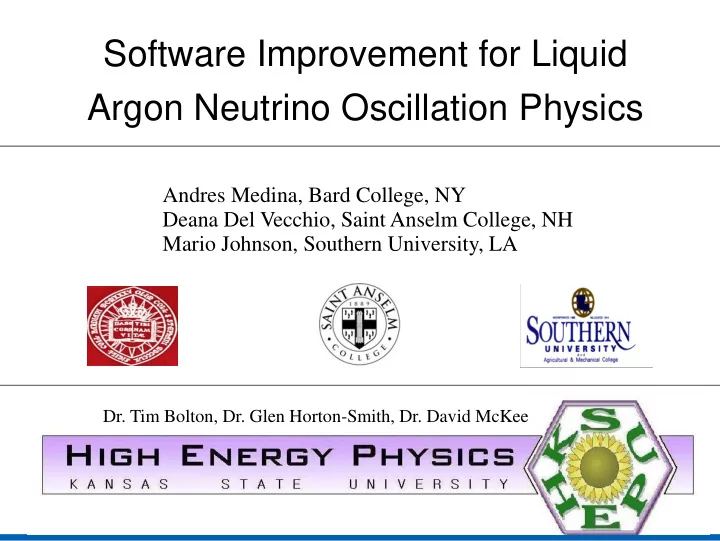

Software Improvement for Liquid Argon Neutrino Oscillation Physics Andres Medina, Bard College, NY Deana Del Vecchio, Saint Anselm College, NH Mario Johnson, Southern University, LA Dr. Tim Bolton, Dr. Glen Horton-Smith, Dr. David McKee
LArTPC • L iquid Ar gon T ime P rojection C hamber • Reasons for using Argon • Purpose of LArTPC experiments
ArgoNeuT • How does it work?
Neutrino Beam Physics • What are neutrinos? • Why neutrinos? • Neutrino oscillations • What is neutrino mixing?
Challenges in Programming • Learning to use C++ • Programming within a framework (LArSoft) • Programming for detector independence
Calculating Resolutions By Deana Del Vecchio
Goals: • Calibrating the uncertainty of the timing differences between wires • Calculating the angular resolution between track like objects
Uncertainty on Wires Spread in the angles Timing difference between hits on three consecutive wires
Timing spread (1,3,5,7)
The Uncertainty Graphs of the Error VS The Timing Error Squared Error
Differentiating between tracks Can differentiate two track-like objects within .032 radians ( ~1.8 ° ) and within 1 wire
Big Picture Working in Liquid Argon Time Projection Chamber (LArTPC) All data simulated and analyzed in LArSoft program Testing the charge deposition of protons to measure Birk’s Constant
During The Summer Programming in LArSoft Simulated experiments Tested saturation limits
Reasons for Research Studying the relationship between neutron energy, proton energy and measured charge in the detector No naturally occurring proton sources 𝑒𝐹 Need different 𝑒𝑦 values (i.e. lower value for Muons and higher values for Protons)
Birk’s Constant Calculation 𝑒𝐹 ∆𝑅 0 = 𝐷 ∙ 𝑒𝑦 ∙ ∆𝑦 Ideal Situation: ∆𝑅 𝐸 = 𝑙 ∙ ∆𝑅 0 Actual Situation: ∆𝑅 0 ∆𝑅 𝐸 ≈ 𝑙 1+𝐿 𝐶 ∙ ∆𝑅 0 K B = Birk’s Constant
Results 14 MeV Proton Total Charge 21 MeV Proton Total Charge
Particles ID Identification for Tracks in LArTPC MicroBooNE ArgoNeuT
What have I been trying to do in the past 9 weeks? • ID identification for Tracks. • Figure out the particles that are inside the detector in a particular event. • Why Kaons? – Measurement of cosmogenic kaon backgrounds for proton decay searches
Results Kaons Energy: 0.5 GeV
Genie and Prodsingle Prodsingle Generator MC Genie Generator MC
Kaon Count Prodsingle Genie
Event Display
Continue
Problems with the Track and Possible Solution • The Track Identifier is not working well • Use others trackers such as Bezier Track
In Conclusion… • Deana has developed an angular and timing resolution filter for the framework • Mario has been developing ways to detect the energy deposition of particles and calibrating Birk’s Constant • Andres has been working on an identifier for particle tracks.
Back up
Bethe – Bloch Equation β = v/c e = electron charge v = velocity of particle m e = electron rest mass E = Energy of particle n = electron density of target z = particle charge I = mean excitation of potential target ε 0 = vacuum permittivity x = distance particle traveled c = speed of light
Recommend
More recommend